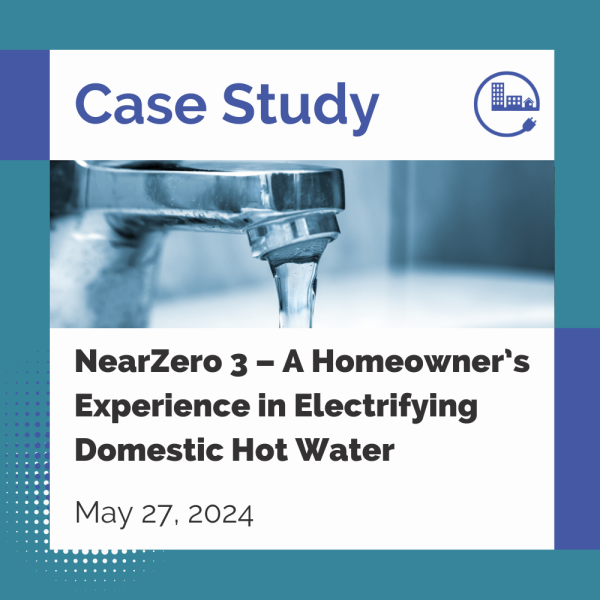
"In a typical home, water heating is the second highest use of energy, while space heating is the first. Water heating accounts for about 37% of greenhouse gases emitted from a residential home in British Columbia (BC).”
Source: The Near Zero Stream 3 program
Near Zero Stream 3 is a City of Vancouver program that ran from February 2023 to March 2024, aimed at accelerating the switch from fossil fuels to 100% electric domestic hot water heating in homes. Participating homeowners were compensated for providing information related to their projects and additional funds were provided for homes that required electrical upgrades or load management devices. Documented homeowner and contractor experiences in domestic hot water replacements helped identify challenges and potential opportunities for gas-to-electric hot water equipment replacement.

Motivations for participating in NearZero 3
As homeowners, we installed a heat pump in 2019; the provincial and municipal incentives available at the time (CleanBC and the City of Vancouver) made it a no-brainer from a financial perspective. Since then, we have continued discussions about getting the house “electric-ready” and reducing our carbon footprint. BC has signalled that it’s likely that conventional gas space and water heating appliances will not be sold in the future. We want to be prepared for that transition.
Electrifying our domestic hot water brings another benefit; getting rid of our gas appliances is an opportunity to gain more storage space. Not having a gas furnace or hot water tank means we could remove the chimney, giving us more storage space in the utility room. We could create a pantry in the kitchen.
The NeroZero 3 program made a big difference in influencing our decision. Our gas water heater was only six years old, so we could have held off on switching for a few more years. However, the program prompted us to make a decision ahead of schedule. Admittedly, even with the NearZero 3 honorarium, it wasn’t an easy choice to make the switch from a purely financial perspective. If we were only going to switch to the hot water tank, it’s unlikely we would have proceeded, but the economies of scale for the electrical work for the stove, dryer, and future EV, made the whole electrification package more attractive.
Electrification requires advance planning
Going into the project, one of our biggest concerns was whether we would need an electrical upgrade and if so, would we need to dig a trench to bring the hydro cable to our house. We heard conflicting information from friends. Some shared challenges in dealing with utility providers, while others shared their experience of outrageous costs. Other friends reassured us that 100A or 125A was more than adequate for their fully electric homes.
It felt like we were entering the big unknown. Getting the heat pump installed a few years previously was quite an undertaking; understanding incentive requirements, finding a contractor, and receiving conflicting information from contractors about what kind of equipment to install and where it could be installed were all challenging. We were nervous to embark on the domestic hot water project and run into similar challenges. Nevertheless, we figured it was worth contacting some electricians to see what they had to say.
The first electrician we contacted came over to assess our situation. The good news was that we didn’t need to dig a trench, because the utility pole was in “a good spot”. Based on quick back-of-the-envelope calculations, the bad news was that we would need a service upgrade. Moreover, our electrical panel is located on the opposite side of the house from the water tank, gas dryer and stove; pulling cables across the house would require a lot of drywall repairs. He gave us an estimate of $10k with drywall repairs in addition. Ouch!
The next electrician experiences weren’t much better. We attempted to reach out to a few more recommended by friends, but they either didn’t reply or were too busy to come by at short notice to provide an estimate. Anecdotally, several friends suggested that the electricians may have felt the job was too “small” and not worth their time given the high demand for their services.
Finally, we contacted our heat pump contractor, Combined Comfort Solutions (CCS), which has electricians on staff. Our contractor recommended running cables outside the house and through the attic to the other side of the house. This was a brilliant alternative and avoided damaging the drywall. As we have learned over the years, our drywalling skills are terrible.
In addition, to accommodate a future EV charger, CCS also suggested the electrician pull teck cable from the dryer electrical outlet to the outside of the house using the dryer circuit. As a result of the suggestion, the three new cables are in addition to the teck cable and coolant lines running on the outside of the house for our heat pump.
CCS’s electrician also did a conventional load calculation and found we would use 91A of capacity with the added hot water, dryer/car charger, and stove circuits. More good news—an electrical upgrade was not necessary!
As an additional illustration, I pulled up our electricity use for the previous three years. Applying Rule 8-106 8 from the Technical Safety BC guidelines, we are nowhere near requiring an upgrade. Our maximum usage, including the safety factor of 25%, was 26A out of our 100A service.

Capital and Operating Costs
Our total investment for the project was $4,803.75, which included an additional $1,600 +GST for the dryer and stove electrical work.
According to listed energy factor specifications, the new water heater is 48% more efficient than the gas one.
Expected electricity operating cost of new equipment is 135 kWh/month at $13/$19 per month (step1/step 2). Our BC Hydro electricity bills typically go into step 2 in the winter and back to step 1 in the summer. Based on allocating 60% of our gas bill to the water heating, we calculated the operating cost of the gas water to be $8.94/month. Our expected greenhouse gas emissions saving is 432 kg/CO2e per year.
Lessons learned
- Location, location, location - The utility room was in an unfortunate location in relation to the electrical panel. Pulling cable across the house added costs to the project. If the utility room was located in a crawlspace or an undeveloped basement, costs would be dramatically lower. Since existing buildings are all different, this could be a common challenge for owners to resolve.
-
Low awareness of alternative guidance - Neither of the electricians who came to give estimates seemed familiar with the Technical Safety BC guidance. This is an area where increased awareness and education for electricians is needed in order to avoid costs for unnecessary upgrades. In addition, it could make a difference in terms of calculating how much capacity is actually required to electrify homes across the province. Future occupants’ use of the home may change the calculations, but actual electricity consumption and Rule 8-106 8 are important factors to consider.
-
It’s not about the money - In our research, we learned that electric water tanks last longer, which increases the financial benefit of making the switch by a marginal amount. However, at current utility rates, there is no clear economic benefit to fuel switching unless you move to a heat pump water heater. Given the size and airflow in our utility room, the heat pump was not an option for us.
-
Plan ahead - We recognize that we are in a very privileged position to make this decision. We also know, from our experience with our heat pump installation, that electrification requires careful planning. Currently, in an emergency replacement scenario, switching from gas to electricity would be extremely difficult.
-
Considerations in going all-electric - We don’t know when we’ll switch out the gas dryer and stove. There are obvious cost implications with purchasing new appliances. Beyond costs, we are concerned about being wasteful by replacing appliances before the end of their useful life. We are interested in an induction stove, but that will require purchasing a new set of pots compatible with induction. Selling our old appliances to recover some of the cost and donating our pots is an option. However, from a moral perspective, it seems a bit ironic to sell gas appliances to others who are in a less favourable economic position to switch to an electric appliance.
Written by Ben Wu
Near Zero Stream 3 is a City of Vancouver program that ran from February 2023 to March 2024, aimed at accelerating the switch from fossil fuels to 100% electric domestic hot water heating in homes. Participating homeowners were compensated for providing information related to their projects and additional funding was available for homes requiring electrical upgrades or load management devices. Homeowner and contractor experience in domestic hot water replacements helped identify challenges and potential opportunities for gas-to-electric hot water equipment replacement.
 b2e@zeic.ca
b2e@zeic.ca


